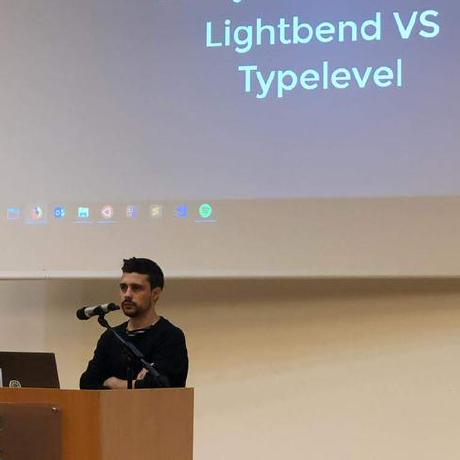Spark Datasets and type-safety
Spark 2.0 has introduced the Datasets API (in a stable version). Datasets promise is to add type-safety to dataframes, that are a more SQL oriented API. I used to rely on the lower level RDD API (distributed Spark collections) on some parts of my code when I wanted more type-safety but it lacks some of the dataframe optimizations (for example on groupBy and aggregations operations). The recommended way is now to use datasets everywhere (except if you’re doing something very specific and if you need to use the low level RDD funcstions). Let’s see how it looks.
This is the classical word count using RDD :
val textFile = sc.textFile("hdfs://...")
val counts = textFile.flatMap(line => line.split(" "))
.map(word => (word.toLowerCase, 1)) // put 1 with each word instance
.reduceByKey((accumulator, current) => accumulator+current) // add all words, grouped by value (by key)
And the word count with dataframes :
val df = sparkSession.read.text("hdfs://...")
val wordsDF = df.select(split(df("value")," ").alias("words"))
val wordDF = wordsDF.select(explode(wordsDF("words")).alias("word"))
val wordCount = wordDF.groupBy(lower($"word")).count
The drawback is that you loose the type information and the field names, so you need to use columns names as strings, which can be error-prone. Also, my personal opinion for this kind of example is that map/flatMap operations are easier to read.
With datasets, you have a mix of RDD and dataframes, with an high level API while retaining some type information :
sparkSession.read.text("hdfs://...").as[String]
.flatMap(_.split(" "))
.groupByKey(_.toLowerCase)
.count()
This version is the easiest to read and to understand. So, it seems perfect! But… if you try to do some more complex operations on rows, you will quick fallback on the non type-safe API.
For example, if you want to order the words by count :
sparkSession.read.text("hdfs://...").as[String]
.flatMap(_.split(" "))
.groupByKey(_.toLowerCase)
.count()
.orderBy($"count(1)".desc) // WTF
Note : The count column name is pretty weird, but it gets a little better if you use groupBy (which is not type-safe) instead of groupByKey :
sparkSession.read.text("hdfs://...").as[String]
.flatMap(_.split(" "))
.map(_.toLowerCase)
.groupBy($"value") // value is the default column name
.count()
.orderBy($"count".desc)
You will also have this kind of problem if you want to join 2 datasets :
//dataset creation from a Seq
val departments = Seq(
Department(1, "rh"),
Department(2, "it"),
Department(3, "marketing")
).toDS
val people = Seq(
Person("jane", 28, "female", 2000, 2),
Person("bob", 31, "male", 2000, 1),
//...
).toDS
people.joinWith(departments, people("deptId") === departments("id"))
Here again you have to pass the column names as strings. To be honest, it’s still easier than the RDD equivalent, where you would have to create (key, value) pair RDDs to be able to join data :
val departmentsById = departments.rdd.map{ department =>
(department.id, department)
}
val peopleByDepartmentId = people.rdd.map{ person =>
(person.deptId, person)
}
peopleByDepartmentId.join(departmentsById)
Let’s go back to the main subject of this post : datasets. With more complex operations, type-safety is still far from perfect :
people.filter(_.age > 30)
.join(departments, people("deptId") === departments("id"))
.group(departments("name"), $"gender")
.agg(avg(people("salary")), max(people("age"))) // average salary and max age
Yes, that can be disappointing… but, there is a library named Frameless, based on the awesome Shapeless, that can add more type-safety to datasets!
import frameless.TypedDataset
val departments = TypedDataset.create(Seq(
Department(1, "rh"),
Department(2, "it"),
Department(3, "marketing")
))
val people = TypedDataset.create(Seq(
Person("jane", 28, "female", 2000, 2),
Person("bob", 31, "male", 2000, 1),
//...
))
val joined = people.join(departments, people('deptId), departments('id))
// val joined = people.join(departments, people('detppid), departments('id)) <-- Won't compile as 'detppid symbol is wrong
As you can see on the last line, if you provide a bad column name, you will get a compilation error. Pretty great isn’t it?
Another problem with regular datasets is that they can produce null values, for example using left outer joins :
departments.joinWith(people, departments("id") === people("deptId"), "left_outer").show
The output is :
// +-------------+--------------------+
// | _1| _2|
// +-------------+--------------------+
// | [1,rh]|[linda,37,female,...|
// | [1,rh]|[john,45,male,300...|
// | [1,rh]|[bob,35,male,2200,1]|
// | [1,rh]|[bob,31,male,2000,1]|
// | [2,it]|[joe,40,male,3000,2]|
// | [2,it]|[jane,28,female,2...|
// |[3,marketing]| null| <--- WARNING : null
// +-------------+--------------------+
//
With Frameless, you won’t have this problem as it gives you Options :
val leftJoined: TypedDataset[(Department, Option[Person])] = departments.joinLeft(people, departments('id), people('deptId))
Frameless is still described as a “proof of concept” and does not cover all dataset operations, but I think it’s an interesting library to follow!
